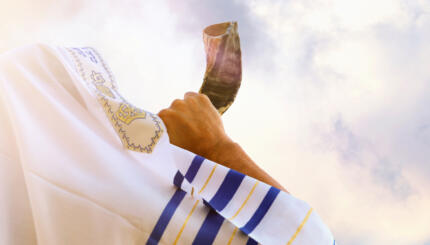The minor fast days are an example of how collective memory is given expression in Judaism. In his first article “Collective Memory,” the author explored how the Jewish mandate to remember was expressed throughout Jewish history. In the following article, Roskies tackles modern events and how they have affected collective memory, wondering whether the traditional paradigm for addressing collective memory is still valid today. He looks at a number of issues and responses that have shaped modern Jewish life: 1) Emancipation and the repercussions it has had on Jewish thought and culture, 2) the trauma of the Holocaust and whether that has called for new paradigms, and 3) how contemporary dependency on visual imagery has influenced Jewish culture which traditionally depended on the written word. Reprinted with permission of The Gale Group from Contemporary Jewish Religious Thought, edited by Arthur A. Cohen and Paul Mendes-Flohr, Twayne Publishers.
Scholars are divided as to the continued viability of Jewish group memory in the modern era. Some, pointing to the fragmentation of art and consciousness in the high culture of Western Europe, conclude that group memory suffered an irreversible blow with emancipation. Others, drawing on the folklore, literature, art, and politics of Jewish eastern Europe, argue that group memory was transformed and revitalized in a secular mode.
The anti-traditionalist revolt–launched in Eastern Europe by such intellectuals as [the writers] S. Y. Abramowitsch (Mendele Mokher Seforim) and Hayyim Nahman Bialik–rejected the theological premise of sin and retribution as the guiding principle of history, but continued nonetheless to disassemble the czarist pogroms, the expulsions, and the mass exodus in terms of the ancient archetypes. An apocalyptic mode of response gained momentum during and after World War I and the Bolshevik revolution, especially among cosmopolitan writers drawn to radical politics. These latter-day apocalyptic writers revived the mythic approach to history, reclaiming Jesus, Shabbetai Zevi [a 17th-century false Messiah], and Solomon Molcho [a 16th-century false Messiah], as prophets of the millennium… Events deliberately suppressed by the rabbis, such as the siege and defeat of Masada, took on mythic significance in this period of revolutionary upheaval….
At the same time, a neoclassical trend also took hold among those writers and political thinkers who focused on the fate of the Jews. The normative past yielded material for a spate of historical novels and family sagas, enormously popular in the interbellum period, while new meanings were discovered for the collective archetypes of kiddush ha-Shem [dying to sanctify God’s name]and the kehillah kedoshah (the holy congregation). Even when used ironically, as in the work of S. Y. Agnon, these archetypes rendered the immediate crisis of European Jewry transtemporal.
With your help, My Jewish Learning can provide endless opportunities for learning, connection and discovery.
The Effect of the Holocaust
Both the apocalyptic and neoclassical modes of response came together in the Nazi ghettos. Here, Yiddish, Hebrew, and, to some extent, Polish writers drew upon modern and classical Jewish texts alike in an effort to withstand the Nazi terror. Jews of all ages and political persuasions recognized the ghetto, the yellow star, the Judenrat (Jewish Council, appointed by German occupying authority), and the myriad acts of sacrilege as something already experienced, and this pervasive sense of deja vu strengthened the search for archetypes. The more brutal and unprecedented the violence became, however, the more the ghetto poets, songwriters, and chroniclers subjected the familiar modes of response to parody. As the full extent of the Nazis’ genocidal plan became known, secular writers such as Itzhak Katznelson and Abraham Sutzkever lent their voices to the cause of armed resistance while, paradoxically, they also revived the covenantal dialogue with God.
Modern Events as Archetypes
In the postwar era, to the extent that Jews have regrouped in large numbers, they have reshaped contemporary events into new archetypal patterns: hurban [destruction, usually used in reference to the Temples] has given way to Shoah (Holocaust); the rebirth of the State of Israel has provided a concretized image of the ingathering of the exiles and of the return to Zion. More recently, the national reawakening of Soviet Jews is viewed as a latter-day exodus.
Each of these three archetypes is celebrated with new communal rituals (public gatherings, parades, demonstrations), while the literary sources read at such occasions begin to take on liturgical significance. In particular, the phenomenon of yizker-bikher–memorial volumes to the destroyed communities of Europe–attests to the renewed vitality of group memory among the survivors of the Holocaust. In contrast to this traditional, collective focus, the exploits of individual heroes are celebrated in Israel by “the issuing of memorial volumes to the fallen soldiers, in addition to legends that are told about Joseph Trumpeldor and other Zionist leaders.
Visual Iconography
The use of visual iconography–in painting, sculpture, and photography–is a new vehicle of group memory in modern times. Images of exile and martyrdom, revolt and rebirth, have made the archetypes accessible to an audience increasingly cut off from written Jewish sources. But given the eclectic nature of modern art and the dearth of icons in Judaism, borrowings from non-Jewish culture are inevitable. Chagall’s Crucifixion Series (1938-1944) exemplifies the strengths and weaknesses of using Jesus as an emblem of Jewish suffering. (Cf. David G. Roskies, Against the Apocalypse: Responses to Catastrophe in Modern Jewish Culture, 1984.)
And so while the link between memory and covenant has been irrevocably broken, while individual actions are now celebrated along with those of the collective, while old archetypes are displaced by new ones, and while visual images supplant the written word, it would seem that group memory and archetypal thinking are still a viable form of Jewish self-expression.
Sign up for a Journey Through Grief & Mourning: Whether you have lost a loved one recently or just want to learn the basics of Jewish mourning rituals, this 8-part email series will guide you through everything you need to know and help you feel supported and comforted at a difficult time.


